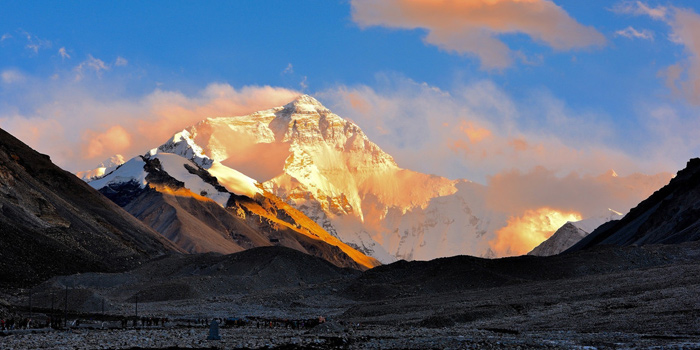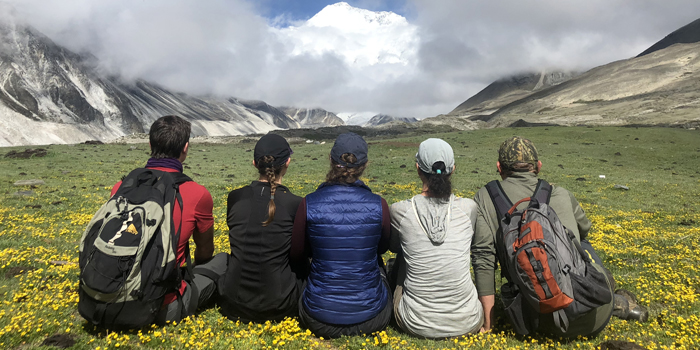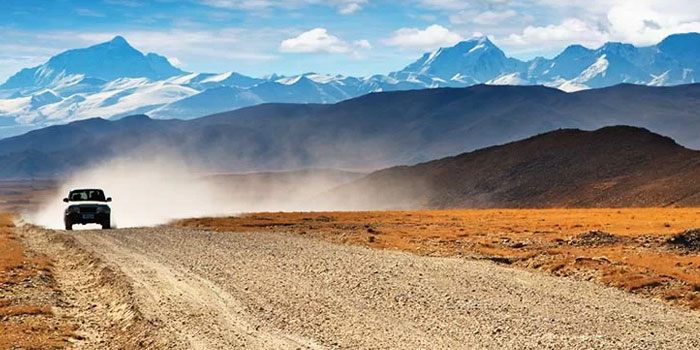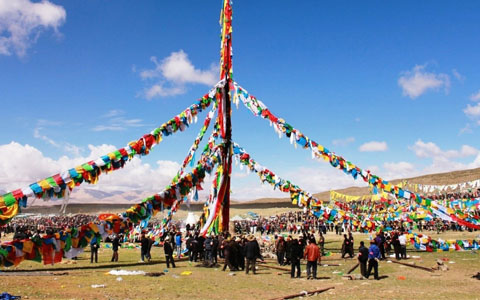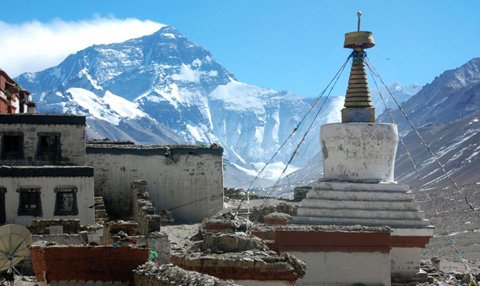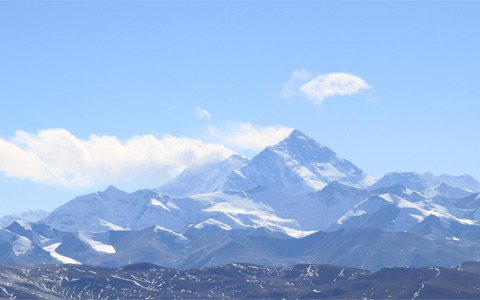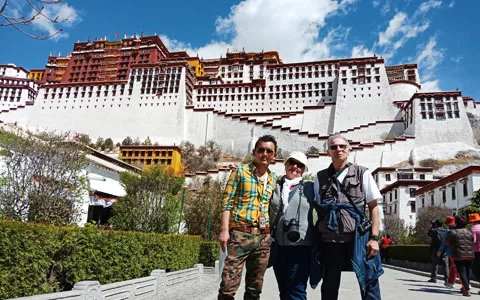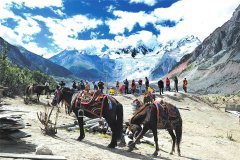Tibet Landscape: the Unique Landscapes You Can't Find in Other Destinations
If you're thinking of traveling to Tibet, you've picked the right place. Unlike other places on this planet, Tibet is a holy land of distinctive charm. It has many unique and top-notch landscapes, which are exactly the reason why many tourists go out of their way to visit this land. Check this article to find out what you can expect during your trip to Tibet.
 How is the Tibet Landscape in General?
How is the Tibet Landscape in General?
 World'Highest Plateau: An Average Altitude of Over 4000 meters
World'Highest Plateau: An Average Altitude of Over 4000 meters
 Snow-Capped Towering Mountains: Mount Everest and More Peaks Over 8000 meters
Snow-Capped Towering Mountains: Mount Everest and More Peaks Over 8000 meters
 Pristine Lakes: Tibet Has the Largest Number of Alpine Lakes on Earth
Pristine Lakes: Tibet Has the Largest Number of Alpine Lakes on Earth
 Enchanting Valleys: Adding More Nature Beauty and Travel Experiences
Enchanting Valleys: Adding More Nature Beauty and Travel Experiences
 Vast Barrens: the Largest Tertiary Strata Earth Forest in the World
Vast Barrens: the Largest Tertiary Strata Earth Forest in the World
 Massive Glaciers: the Witness to the Transformation of the Earth
Massive Glaciers: the Witness to the Transformation of the Earth
 Alpine Desert: the Often Overlooked yet Beautiful Landscape in Tibet
Alpine Desert: the Often Overlooked yet Beautiful Landscape in Tibet
 Lush Forest: Vibrant Greenery Flourishing in Nyingchi and Gyirong Border
Lush Forest: Vibrant Greenery Flourishing in Nyingchi and Gyirong Border
 Majestic Rivers: Great Rivers Running All the Way Across Asia
Majestic Rivers: Great Rivers Running All the Way Across Asia
 Isolated Uninhabited Area: Like the Hoh Xil in Northern Tibet
Isolated Uninhabited Area: Like the Hoh Xil in Northern Tibet
 Vast Grasslands Where Tibetan Nomads Have Lived for Thousands of Years
Vast Grasslands Where Tibetan Nomads Have Lived for Thousands of Years
 Blue Sky and White Clouds: Deeper Blue Sky with More Various Shapes of Clouds
Blue Sky and White Clouds: Deeper Blue Sky with More Various Shapes of Clouds
How is the Tibet Landscape in General?
Tibet's landscape is a world of rugged beauty and awe-inspiring grandeur. Sitting on top of the world's highest plateau, the terrain is characterized by vast plateaus punctuated by towering mountain ranges that pierce the heavens. These mountains, including the iconic Himalayas and the formidable Kunlun, overlook a land of contrasts.
Amidst the highland deserts, stretches of arid desolation give way to oases of life around pristine lakes. The plateau's heart reveals sweeping grasslands where yaks roam freely and nomads carry on their traditional lifestyle. Rivers born from glaciers have carved deep valleys and canyons, unveiling a geological drama of colossal proportions.
World'Highest Plateau: An Average Altitude of Over 4000 meters
Known as the “roof of the world” and the “third pole”, the Tibetan Plateau is the highest in the world, with an average altitude of over 4,000 meters, and an area of about 2.4 million square kilometers.
Lying on the northern side of the Himalayan Mountains, the Tibetan Plateau is home to ten of the world’s highest mountains. Dotted with rivers and lakes, it is also the birthplace of many of Asia’s major rivers, such as the Yellow River, Ganges, and Indus.
 Tibetan Plateau is the world'highest plateau with an average altitude above 4000 meters.
Tibetan Plateau is the world'highest plateau with an average altitude above 4000 meters.
During its long geological development, the Tibetan Plateau has not only formed alpine grasslands and meadows, but also deserts, wetlands, and various kinds of forests that are very different from the rest of the world.
In this special geographical environment, there are many spectacular geological sites and gorgeous natural landscapes, as well as rich fauna and flora that can truly impress every visitor to this place.
Snow-Capped Towering Mountains: Mount Everest and More Peaks Over 8000 meters
Tibet’s mountains are prime examples of Earth’s geological wonders. More than just features of the landscape, these mountains stand as cultural and spiritual icons with their snow-capped summits and dramatic slopes, and inspire reverence among local people and visitors alike, representing the raw power of nature.
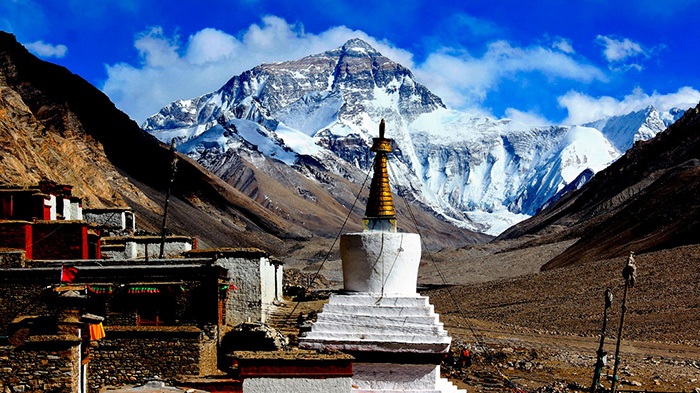 The amazing view of Mt Everest and Rongbuk Monastery on Tibetan side
The amazing view of Mt Everest and Rongbuk Monastery on Tibetan side
Mount Everest, the main peak of the Himalayas, is known as the highest peak in the world with a height of 8,848.86 meters. One can travel along the well-paved road from Lhasa to Everest Base Camp, where the view of Mt. Everest is gorgeous. In addition, one can also see stunning sunset or sunrise of Everest peak. At night, there is also a chance to watch the starry sky at EBC or Rongbuk Monastery.
 Mt. Kailash is the most sacred mountain in Tibet.
Mt. Kailash is the most sacred mountain in Tibet.
Although Mt. Kailash is only 6,656 meters above sea level, it is a mountain that has never been climbed. Since it is a world-famous holy mountain, it is sacred and not to be climbed. But every year Mount Kailash is visited by many people seeking blessings from the famous kora. The whole Mount Kailash kora route is about 52 km long, and normally needs 3 days for most tourists.
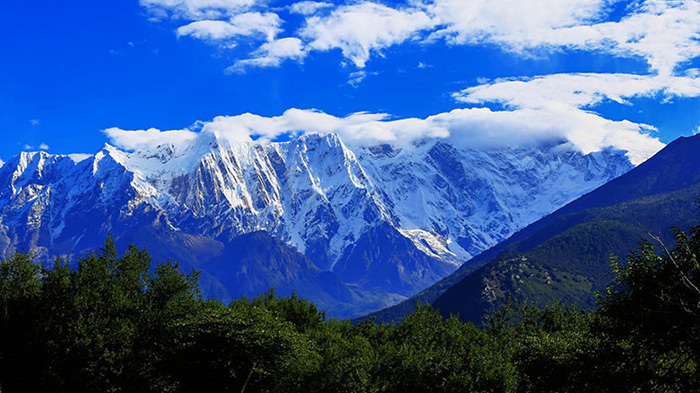 It is said that only the lucky person can see the peak of Mt. Namcha Barwa.
It is said that only the lucky person can see the peak of Mt. Namcha Barwa.
Mount Namcha Barwa is the highest peak in Nyingchi Prefecture of Tibet, with an altitude of 7,782 meters. Often hiding behind a veil of clouds, this beautiful snow peak is like a shy beauty. Every year, March and April offer the best chance to see the peak. Witnesses of this rare sight are said to have good luck for a whole year.
Pristine Lakes: Tibet Has the Largest Number of Alpine Lakes on Earth
Spread across vast plateaus, Tibet's lakes shine like gems. From high-altitude saltwater to tranquil freshwater oases, these waters hold significance in Tibet's nature and culture—embracing beauty and spiritual pilgrimage. Three of these, Yamdrok Lake, Namtso Lake, and Lake Manasarovar are known as the three sacred lakes of Tibet, and are popular destinations for visitors.
Yamdrok Lake, less than 100 km from Lhasa, has a more favorable location than the others. While being overlooked from the top of Gangbala Mountain, the lake looks like a piece of sapphire inlaid between mountains. Its convenient location makes it a first choice for travelers with limited time. You can join our 5 days Lhasa Yamdrok Lake tour, to spend a day exploring the lake after touring Lhasa city.
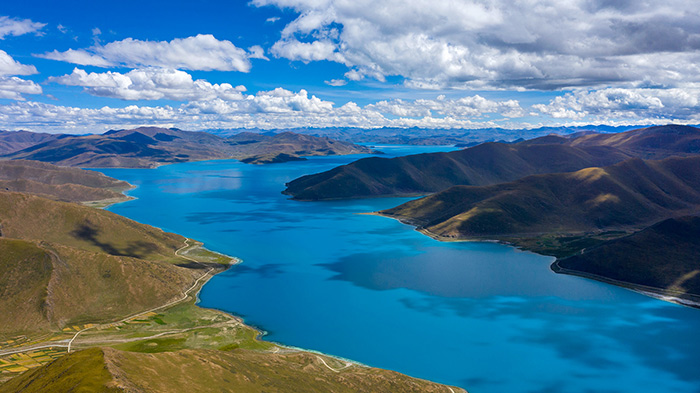 Yamdrok Lake is popular among tourists of all ages.
Yamdrok Lake is popular among tourists of all ages.
Lake Namtso is the most sea-like of the sacred lakes. Surrounded by the snow-capped Nyenchen Thanglha Mountain ranges and endless grassland, Namtso Lake is a paradise for photographers. You can take some gorgeous photos that decorate your Instagram. And in summer, you can also see the grassland blooming with all kinds of flowers, and the herdsmen leisurely grazing their cattle and sheep.
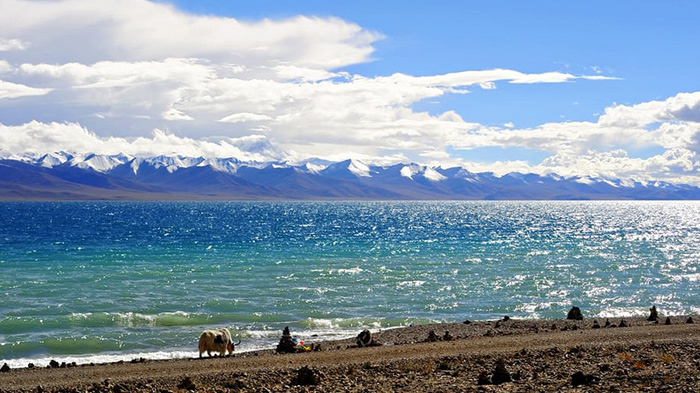 Lake Namtso is a paradise for photographers.
Lake Namtso is a paradise for photographers.
Located 30 km southeast of Mount Kailash, Lake Manasarovar (at 4588 meters above sea level) is among the planet's highest freshwater lakes. A pilgrimage site for global devotees, its water is believed to cleanse worries, delusions, and sins. Lake Manasarovar is also a place not to be missed by tourists. Its extraordinary scenery is enough to enchant everyone who has gone through the hardship of trekking along the way.
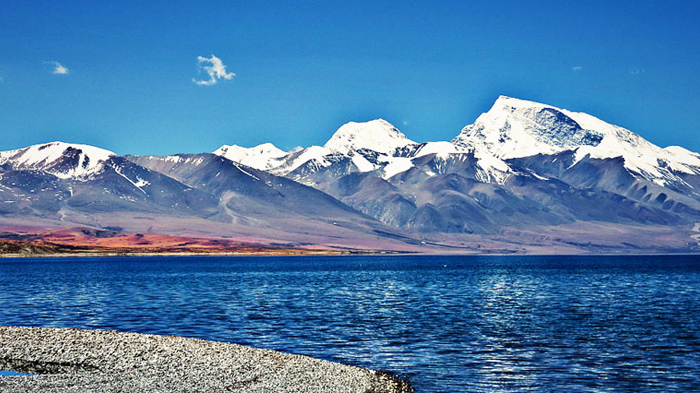 Lake Manasarovar is one of the three holiest lakes in Tibet.
Lake Manasarovar is one of the three holiest lakes in Tibet.
Enchanting Valleys: Adding More Nature Beauty and Travel Experiences
Carved by the passage of water and ice over thousands of years, Tibet's valleys lie in stark contrast to the soaring mountain peaks that surround them. These valleys offer a sanctuary of life and sustenance amidst the dramatic and often unforgiving landscape. While many have been home to Tibetan people for generations, others, such as Gama Valley, stand as examples of pristine nature conservation.
Located in the core area of Everest Nature Reserve, Gama Valley is famous for its steep gorges, lush forests, colorful rhododendrons and crystal clear springs. In the last century, it was praised by American and British explorers as "the most beautiful valley in the world" and "one of the top ten classic trekking routes in the world".
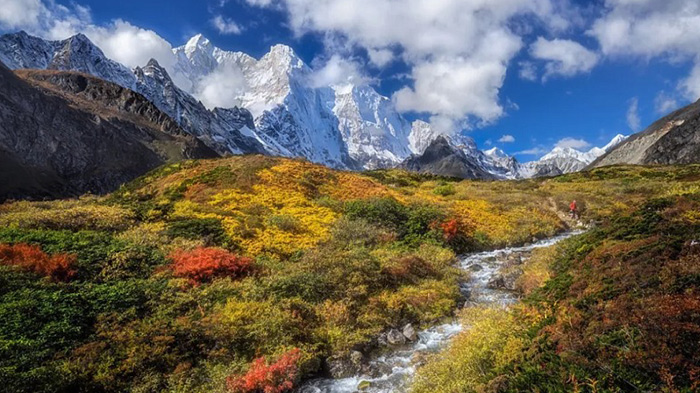 Gama Valley has the best preserved and largest primitive forest in the Everest region.
Gama Valley has the best preserved and largest primitive forest in the Everest region.
The entire valley is off the beaten track and has the best preserved and largest primitive forest in the Everest region. For nature adventurers and trekking lovers, you should not miss this place. While doing the Gama Valley trek, you can admire Mount Everest (the world’s top highest mountain), Mount Lhotse (the world’s fourth highest mountain), and Mount Makalu (the world’s fifth highest mountain).
Vast Barrens: the Largest Tertiary Strata Earth Forest in the World
The Zada Earth forest is an otherworldly geological wonder, with towering earthen pillars and labyrinthine formations that defy imagination. Sculpted by wind and water over the centuries, the soft sedimentary rock has been carved into a stone semblance of a petrified forest.
Located between the Gandise Mountains and the Himalayas, the Zada Earth Forest has undergone geological changes of the ancient great lake basin, long-term water erosion, weathering and stripping, and finally formed its large-scale unique plateau landform.
 Zada Earth Forest is a nature wonder located in Ngari, Tibet.
Zada Earth Forest is a nature wonder located in Ngari, Tibet.
Each earth forest has its peculiar shape, some like vehicles, some like advancing warriors...as long as the viewer has an endless imagination, he or she will be able to feel its countless sides. And at sunset, Zada Earth Forest shows its most charming appearance. The bright evening sunlight gives life to the earth forest, making it look like elegant, jagged castles and palaces.
Massive Glaciers: the Witness to the Transformation of the Earth
Tibet’s massive glaciers stand as captivating symbols of Earth’s ever-evolving geological history. Fed by the accumulation of snow over the centuries, these glaciers shape the land and influence weather patterns, while their meltwaters feed into the headwaters of major Asian rivers. They exist in a remarkable range of sizes and forms, harboring secrets of Earth’s history within their frozen layers.
The Karola Glacier, located in the Nyenchen Tanglha Mountain range, is one notable example. Showcasing the grandeur of Tibet's icy landscapes with its intricate network of crevasses and icefalls, the glacier embodies the sheer power and dynamism of Earth's natural processes. It's a vivid reminder of how glaciers sculpt mountains and valleys, shaping the very contours of the land.
 Tourists have visited the Karola Glacier on the way from Lhasa to EBC.
Tourists have visited the Karola Glacier on the way from Lhasa to EBC.
Rongbuk Glacier holds a place of prominence in the Himalayan landscape as the largest glacier on the northern slope of Everest. Nestled beneath its towering peak, the lake is an integral part of the journey for climbers attempting to conquer the mountain as they make their way through the Rongbuk Valley towards Everest Base Camp. It has also become a poignant symbol of the impact of climate change. Still remaining an impressive sight, the retreat of the glacier is evident in the visible reduction of the glacier's size and the increasing exposure of rocky terrain that was once buried under ice.
Another major glacier, the Midui Glacier, stands out for its striking turquoise hues set against the backdrop of snow-capped mountains. Situated in southeastern Tibet, this surreal and mesmerizing glacier feeds Midui Lake with its meltwater, a testament to the complex interplay between ice and water that characterizes the local ecosystem.
Alpine Desert: the Often Overlooked yet Beautiful Landscape in Tibet
The alpine deserts of Tibet reveal a unique facet of the region’s diverse terrain. Found within the high-altitude expanse of the Tibetan Plateau, these arid expanses offer a mesmerizing contrast to the towering mountains and lush valleys that often capture the spotlight.
The deserts along the banks of the Yarlung Tsangpo are a place of vast sand dunes, rocky outcrops, and barren stretches that extend endlessly to the horizon. These deserts, sculpted by the whims of the wind and the scarce rainfall, epitomize the resilience of life in challenging environments.
 Group photo taken at the bank of the Yarlung Tsangpo
Group photo taken at the bank of the Yarlung Tsangpo
Tibet Desert Park is an endeavor to preserve and showcase the unique desert ecosystems of the region. This park is home to the often-unnoticed life that thrives in these arid expanses, from the hardy desert plants to the elusive animals that have evolved to survive in the harsh conditions. It offers a window into the intricate relationships that sustain life even in seemingly inhospitable landscapes.
Lush Forest: Vibrant Greenery Flourishing in Nyingchi and Gyirong Border
Part of the rich contrast in the landscape of Tibet are the lush forests that stand out in their vibrant greens against the rugged terrain of the plateaus. These dense woodlands are home to a thriving ecosystem that flourish in the face of the sparse life surrounding them.
 Enjoying exploring the Lulang Forest of the Nyingchi Prefecture
Enjoying exploring the Lulang Forest of the Nyingchi Prefecture
Lulang Forest, located in the Nyingchi Prefecture, is a stunning example of natural beauty. Nestled within the folds of the Himalayan foothills, it is characterized by lush greenery, rolling hills, vibrant meadows, and dense coniferous and deciduous trees. Lulang Forest is particularly famous for its vibrant autumn colors, when the leaves of the trees transform into shades of gold, red, and orange, creating a captivating and picturesque scene.
The Gyirong region, bordering Nepal, shows another side of Tibet's diverse landscapes. The forests here are a testament to the remarkable biodiversity that thrives in this relatively less explored part of Tibet. Dense woodlands shelter a variety of species, from elusive wildlife like the red panda to an array of birdlife, making it a hotspot for nature enthusiasts and conservationists alike.
Majestic Rivers: Great Rivers Running All the Way Across Asia
The great rivers of Tibet are born from the glaciers and highlands and serve as the lifeblood of the Asian continent as they flow through the landscape. Not only vital for the communities that depend on them but the rivers also play significant roles in shaping the cultural, ecological, and economic tapestry of Asia, their majestic beauty is something not to be missed.
The Yarlung Zangbo River, also known as the Brahmaputra in its lower reaches, is one of the world's mightiest rivers. It cuts a dramatic path through the rugged terrain, creating deep gorges and valleys. As it flows into India, the Brahmaputra sustains the fertile lands of the Ganges-Brahmaputra Delta, making it a lifeline for millions of people.
Another important river is the Yangtze River, often referred to as the "Mother River of China." It begins its journey in the Tibetan Plateau and stretches across several provinces, carving through stunning landscapes such as the famous Three Gorges. The Yangtze River is a symbol of China's history and cultural significance, playing a vital role in trade, transportation, and agriculture.
Isolated Uninhabited Area: Like the Hoh Xil in Northern Tibet
Tibet is still home to isolated and uninhabited areas such as the Hoh Xil in northern Tibet. This desolate, high-altitude region has been recognized as a UNESCO World Heritage Site due to its unique and fragile ecosystem. Its isolation and challenging environment have contributed to the area remaining largely uninhabited by humans.
 Tibetan antelope of the Hoh Xil in Northern Tibet
Tibetan antelope of the Hoh Xil in Northern Tibet
A land of vast grasslands, salt flats and barren expanses, Hoh Xil is nevertheless home to a remarkable array of wildlife that has adapted to the challenging conditions. The region supports populations of Tibetan antelope, wild yaks, wild donkeys, and various bird species. The Tibetan antelope, also known as chiru, is particularly notable for its presence in Hoh Xil, and the protection of this species has contributed to the area's conservation efforts.
Vast Grasslands Where Tibetan Nomads Have Lived for Thousands of Years
The vast grasslands of Tibet have been the ancestral home of Tibetan nomads for thousands of years, a way of life that is deeply connected with the land and its rhythms. These expansive plains stretch across the Tibetan Plateau, supporting the nomads living in harmony with the grasses and grazing animals they support.
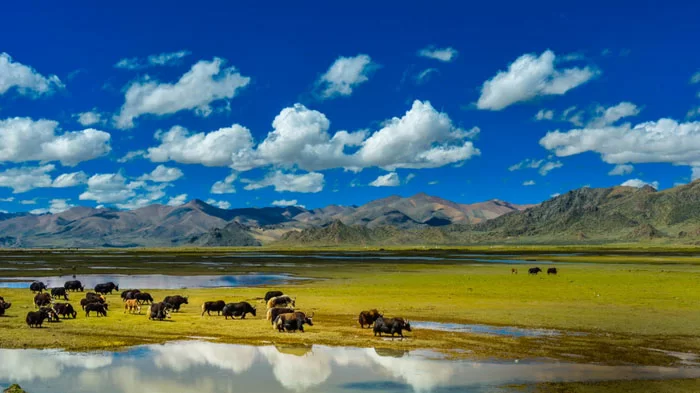 The northern Nagqu Grassland is a prime example of the vast prairies in Tibet.
The northern Nagqu Grassland is a prime example of the vast prairies in Tibet.
Nagqu Grassland, in the northern part of the plateau, is a prime example of the vast prairies. Here nomadic communities have thrived for generations, herding yaks, sheep, and other livestock. They move seasonally across the grasslands, following ancient migratory patterns that ensure their livestock have access to fresh pastures and water sources. This nomadic lifestyle is not only a means of survival but also a cultural tradition that binds families and communities together.
Blue Sky and White Clouds: Deeper Blue Sky with More Various Shapes of Clouds
The blue sky and white clouds of Tibet create symphony of color and shapes that stretch out over the horizon, captivating visitors with the sight. In this elevated region, the sky reaches an azure hue, deeper and more vivid than in many other parts of the world. The low pollution and thinness of the atmosphere contribute by adding striking clarity, and exceptional brilliance.
The clouds are just as enchanting. They give rise to a diverse gallery of shapes, sizes, and textures scattered across the vast expanse of the sky. From delicate wisps that trail across the horizon to massive cumulus formations that seem to touch the mountaintops, the clouds tell stories of ever-changing atmospheric dynamics.
Conclusion
No matter what kind of scenery you are looking forward to seeing in Tibet, you will never be disappointed. The unique land of Tibet boasts so many distinctive landscapes, gorgeous mountains, splendid lakes, valleys and rivers. Just pack your backpack now to join one of our most popular Tibet small group tours, to appreciate the beauty of Tibet with your own eyes!

With exceptional passion and outstanding leadership, Mrs. Catherine has dedicated herself to Tibet inbound tourism and China tour for 15 years. As one of the handful females who see great potential of Chinese inbound tourism, Catherine has made great contribution to promoting Tibet tourism and enhancing the employment of Tibetans and prosperity of local Tibetan community.
Over the years, she travelled overseas with Tibet Tourism Bureau many times to promote Tibet tourism. Currently, Catherine works as the marketing director of Tibet Vista, an opinion leader behind the whole team of Tibet Vista.
Related Articles & Posts
Most Popular Tibet Tour Packages
-

Lhasa - Gyantse - Shigatse - Everest Base Camp - Shigatse - Lhasa
USD939
View Details -

Lhasa - Gyantse - Shigatse - E.B.C - Saga - Kailash Trek - Darchen - Lake Manasarovar - Saga - Gyirong - Tingri - Lhasa
USD2059
View Details -

10 Days Lhasa to Everest Base Camp and Namtso Lake Small Group Tour
Lhasa - Gyantse - Shigatse - EBC - Shigatse - Lhasa - Namtso Lake - Damxung - Lhasa
USD1289
View Details -

8 Days Driving Across Himalaya Overland Adventure from Kathmandu to Lhasa
Kathmandu - Gyirong - Everest Base Camp - Tingri - Shigatse - Gyantse - Lhasa
USD1069
View Details -

4 Days Lhasa Impression Small Group Tour: Explore the Heart of Tibet and Mingle with the Locals
Lhasa
USD509
View Details -

Lhasa - Gyantse - Shigatse - Everest Base Camp - Gyirong - Kathmandu
USD979
View Details -

Lhasa - Gyantse - Shigatse- Lhasa
USD799
View Details -

13 Day Lhasa, Mt. Everest, Mt. Kailash, Lake Manasarovar and Kathmandu Adventure Tour
Lhasa - Gyantse - Shigatse - EBC - Saga - Darchen - Kailash Trek - Darchen - Saga - Gyirong - Kathmandu
USD2059
View Details


.jpg)



